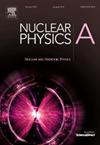最重核的结构
IF 2.5
4区 物理与天体物理
Q2 PHYSICS, NUCLEAR
引用次数: 0
摘要
对最重核的研究不仅是一个实验挑战(由于所涉及的生产截面非常低),而且也是一个理论挑战。事实上,大库仑场和高密度的单粒子态的结合使得理论计算变得困难,并导致极端的模型依赖,例如所谓的“稳定岛”[1]的局部化。此外,最近的实验和理论研究揭示了能量密度泛函(EDF)的缺陷,该泛函用于描述整个核图[2],[3]的核性质。这表明进一步改进EDF方法是必要的,并且需要新的可靠数据来基准测试和约束理论模型。在这次演讲中,将介绍和讨论转移质核结构的最新研究结果。本文章由计算机程序翻译,如有差异,请以英文原文为准。
Structure of the heaviest nuclei
The study of the heaviest nuclei is not only an experimental challenge (due to the very low production cross sections involved), but it is also a theoretical one. Indeed, the combination of large Coulomb fields and high densities of single-particle states makes theoretical calculations difficult and leads to extreme model dependencies, such as for example the localisation of the so-called “island of stability” [1]. Moreover, recent experimental and theoretical studies have shed light on deficiencies of energy density functionals (EDF), which are used to describe nuclear properties across the entire nuclear chart [2], [3]. This suggests that further improvements of the EDF methods are necessary and that new reliable data are required to benchmark and constrain the theoretical models. In this talk, recent results on the structure of transfermium nuclei will be presented and discussed.
求助全文
通过发布文献求助,成功后即可免费获取论文全文。
去求助
来源期刊

Nuclear Physics A
物理-物理:核物理
CiteScore
3.60
自引率
7.10%
发文量
113
审稿时长
61 days
期刊介绍:
Nuclear Physics A focuses on the domain of nuclear and hadronic physics and includes the following subsections: Nuclear Structure and Dynamics; Intermediate and High Energy Heavy Ion Physics; Hadronic Physics; Electromagnetic and Weak Interactions; Nuclear Astrophysics. The emphasis is on original research papers. A number of carefully selected and reviewed conference proceedings are published as an integral part of the journal.
 求助内容:
求助内容: 应助结果提醒方式:
应助结果提醒方式:


